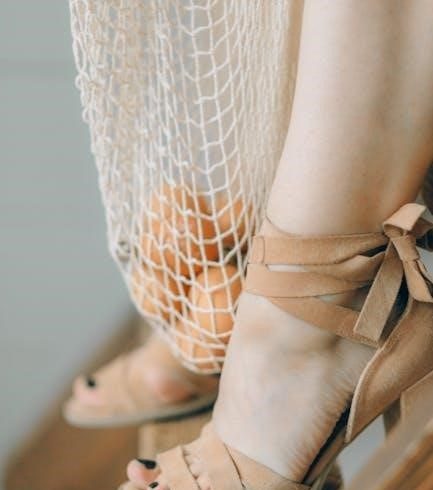Style Guide Listings in Crosswords⁚ An Overview
Crossword puzzles frequently feature clues related to style guides, often referencing specific style manuals (like MLA or APA) or general concepts of style and writing conventions. These clues can range in difficulty, from straightforward to quite cryptic, demanding familiarity with editorial practices and terminology. Solutions vary in length and may involve abbreviations, acronyms, or full names of style guides.
Common Crossword Clue Variations
Clues referencing style guides in crossword puzzles exhibit diverse phrasing. Simple clues might directly ask for the name of a style guide (“Writer’s handbook”), while others employ synonyms (“Editorial manual,” “Formatting guide”). Some clues utilize abbreviations, like “MLA” or “APA,” testing the solver’s knowledge of common style guide acronyms. Cryptic clues might incorporate wordplay, requiring solvers to decipher hidden meanings or puns related to style or editing. For example, a clue might present a sentence fragment illustrating a stylistic error, asking solvers to identify the applicable style guide rule. The complexity can range from simple identification to sophisticated word puzzles, enhancing the challenge for crossword enthusiasts.
Sources of Style Guide Clues
The inspiration for style guide clues in crossword puzzles is multifaceted. Many clues draw directly from the titles or common abbreviations of well-known style manuals, such as the Modern Language Association (MLA) style guide or the American Psychological Association (APA) style guide. Other clues may originate from general writing and editing principles, testing solvers’ understanding of grammar, punctuation, or citation conventions. Newspapers and magazines, known for their adherence to specific style guidelines, can be implicit sources, with clues referencing journalistic style or publishing practices. The clues may also draw on the editor’s own knowledge and experience with style guides, leading to more unique and less predictable puzzle elements. This variety ensures that the clues cater to different levels of expertise among crossword solvers.
Frequency of Appearance in Different Puzzles
The frequency of style guide-related clues varies significantly across different crossword puzzle publications and difficulty levels. In daily newspapers like the New York Times or the LA Times, such clues might appear occasionally, often integrated into the general knowledge sections. More specialized or themed crossword puzzles might feature a higher concentration, particularly those focused on writing, editing, or academia. The difficulty level also plays a role⁚ easier puzzles might include simpler clues referencing commonly known style guides, while more challenging puzzles could use more obscure terminology or indirect references, demanding a deeper understanding of editorial practices. The frequency also depends on the puzzle constructor’s preferences and the overall thematic choices for a particular puzzle edition. Observing the patterns across different puzzles offers valuable insights into the prevalence and placement of these types of clues.
Analyzing Style Guide Crossword Clues
Deconstructing style guide clues involves identifying clue types (direct, indirect, cryptic), analyzing word length and patterns, and recognizing related terms and synonyms to unlock solutions effectively. Careful consideration of the phrasing is key to successful solving.
Clue Types and Structures
Style guide crossword clues exhibit diverse structures and types, demanding varied approaches to solving. Direct clues explicitly name a style guide (e.g;, “Writer’s handbook”). Indirect clues allude to a style guide through associated concepts, such as “Citation format” or “Editorial rules.” Cryptic clues employ wordplay, requiring solvers to decipher hidden meanings or puns related to style guidelines. Some clues might incorporate abbreviations (e.g., “APA” for the American Psychological Association style guide) or use synonyms for “style guide,” like “manual” or “handbook.” The structure can be straightforward, a simple definition, or more complex, potentially incorporating misdirection or wordplay. Understanding these variations is crucial for efficient puzzle-solving. The length of the answer, indicated by the number of squares in the grid, is a vital piece of information for narrowing down possibilities. Finally, the surrounding clues and answers can provide contextual clues that help to deduce the correct solution.
Word Length and Letter Patterns
The length of the answer, as indicated by the number of squares in the crossword grid, significantly impacts the potential solutions for style guide clues. Short answers might point towards abbreviations like “MLA” or “APA,” while longer answers may suggest full names or more descriptive terms. Letter patterns also play a crucial role. The presence of specific letters or common letter combinations can help eliminate possibilities. For instance, a clue requiring a four-letter answer might suggest “APSA” (American Political Science Association) if the grid allows for such a pattern. Analyzing the letter patterns within the grid itself, particularly in intersecting words, can further refine the search for potential solutions; Consider the frequency of certain letters in the English language; certain letter combinations appear more frequently than others, and this knowledge can prove helpful in narrowing down possibilities. The use of crossword solver tools can be especially helpful in leveraging letter patterns and word length to identify potential answers quickly.
Identifying Related Terms and Synonyms
Successfully solving style guide crossword clues often hinges on recognizing related terms and synonyms. Clues rarely use the exact name of a style guide; they might instead employ synonyms or related concepts. For example, a clue might refer to a “writer’s handbook” or a “manual of style” instead of explicitly mentioning “MLA” or “Chicago.” Understanding the broader context of style guides and their purpose is essential. Recognizing terms like “citation,” “bibliography,” “formatting,” “grammar,” or “punctuation” can help connect seemingly unrelated clues to the underlying theme of style and writing conventions. Consider the different ways a style guide might be described—a reference book, a set of rules, a guide to consistency—and think about how these descriptions might be worded in a crossword clue. The ability to identify synonyms and related terms allows solvers to expand their search beyond literal matches and uncover the intended answer. This requires a good grasp of both vocabulary and the underlying concepts of style guides themselves.
Strategies for Solving Style Guide Clues
Employing a multifaceted approach is key⁚ utilize online resources, crossword solver tools, and leverage your knowledge of writing conventions and common style guide acronyms (like MLA or APA) to decipher these clues effectively.
Using Crossword Solver Tools
Crossword solver tools can significantly aid in solving style guide clues. Many online resources and dedicated apps offer functionalities beyond simple word searches. These tools often incorporate pattern matching capabilities, allowing you to input partial solutions or known letter positions. This is particularly helpful with cryptic clues or when dealing with abbreviations commonly found in style guide references. Furthermore, some advanced solvers provide contextual clues based on intersecting words, significantly narrowing down the possibilities. Remember to specify the number of letters in your answer to refine search results. By combining the solver’s suggestions with your knowledge of style guides, you can efficiently identify the correct answer, even for the most challenging clues. Experiment with different solvers; each might have unique features and databases that prove useful in specific situations.
Leveraging Online Resources and Databases
Beyond dedicated crossword solvers, a wealth of online resources can assist in deciphering style guide clues. Websites specializing in style guides, such as those dedicated to MLA, APA, or Chicago style, offer comprehensive information on formatting and terminology. These resources can be invaluable in identifying obscure abbreviations or less common style-related terms that might appear in crossword clues. Searching online for specific terms or phrases from the clue can often lead to relevant style guide entries, helping you understand the intended meaning and potential solutions. Furthermore, online dictionaries and thesauruses can help identify synonyms or related terms that might fit the clue’s context, particularly when dealing with cryptic or indirect clues referencing stylistic elements. Remember to cross-reference information from multiple sources to ensure accuracy and avoid potential ambiguities.
Applying Deductive Reasoning and Pattern Recognition
Successfully tackling style guide crossword clues often involves employing deductive reasoning and recognizing patterns. Start by carefully analyzing the clue’s wording, identifying keywords and potential synonyms related to style or editing. Consider the clue’s length and the likely number of letters in the answer, using this information to narrow down possibilities. If the clue contains abbreviations or acronyms, expand them to determine potential solutions. Look for patterns in the clue’s structure; for instance, a clue might use wordplay or puns related to style guide elements. Pay attention to the surrounding clues in the crossword, as they may provide contextual clues or related terms that assist in solving the style guide clue. By systematically eliminating unlikely possibilities and using the information available, you can deduce the most probable solution based on logical reasoning and pattern recognition within the puzzle itself.
Examples of Style Guide Clues and Solutions
This section will showcase various crossword clues related to style guides, along with their corresponding solutions, illustrating the diversity of question types and answer lengths encountered.
Specific Puzzle Examples and Solutions
Let’s examine concrete instances from various crossword puzzles. For example, the clue “Writer’s guide to formatting” might lead to the answer “MLA” (Modern Language Association), a common style guide in academic writing; Another clue could be “Publication’s style manual,” potentially yielding “AP” (Associated Press) as its solution, given its prevalence in journalistic contexts. A more challenging clue might be “Fashion mag’s style guide,” possibly solved by “ELLE,” reflecting the magazine’s influence in the fashion world. Consider also cryptic clues, such as “Dress code?” which could point to “DRESS CODE” itself, highlighting the importance of adhering to style guidelines. The length of the answer can vary, ranging from short abbreviations like “MLA” to longer phrases like “STYLE GUIDE.” The difficulty also varies, from simple direct clues to more complex wordplay-based ones. The context within the crossword puzzle also plays a crucial role in determining the correct answer.
Analysis of Clue Difficulty and Ambiguity
The difficulty of style guide crossword clues varies significantly. Simple clues directly name the style guide, like “APA style manual,” with “APA” as the straightforward answer. Others employ wordplay or indirect references. For instance, a clue like “Writer’s handbook” could refer to multiple style guides, introducing ambiguity. The solver needs to consider the crossword’s overall theme or context to deduce the intended answer. Ambiguity can also arise from using abbreviations. “AP” could refer to Associated Press or another less-common entity. Clue construction plays a vital role; a cryptic clue might present a riddle or pun, demanding a deeper understanding of language and style guide conventions. The length of the answer also influences difficulty; a short answer like “MLA” is easier to guess than a longer phrase. Therefore, assessing clue difficulty requires analyzing the directness of phrasing, the potential for multiple interpretations, and the length of the expected solution.
Understanding Contextual Clues
Contextual clues are crucial in solving ambiguous style guide crossword entries. The surrounding clues and the overall puzzle theme often provide hints. For example, if the puzzle centers on journalism, an abbreviation like “AP” is more likely to refer to Associated Press than to another less-related acronym. Similarly, if a clue mentions academic writing, “MLA” becomes a strong contender. Cross-referencing related clues is also helpful. A clue referencing a specific citation style might be linked to another clue about a particular writing format or publication style. The puzzle’s difficulty level influences the complexity of contextual clues. Easier puzzles typically use more direct clues, while more challenging puzzles depend heavily on understanding the interconnections between clues. Therefore, effective solvers actively seek connections between clues and use the puzzle’s theme to guide their interpretation of potentially ambiguous style guide references.

